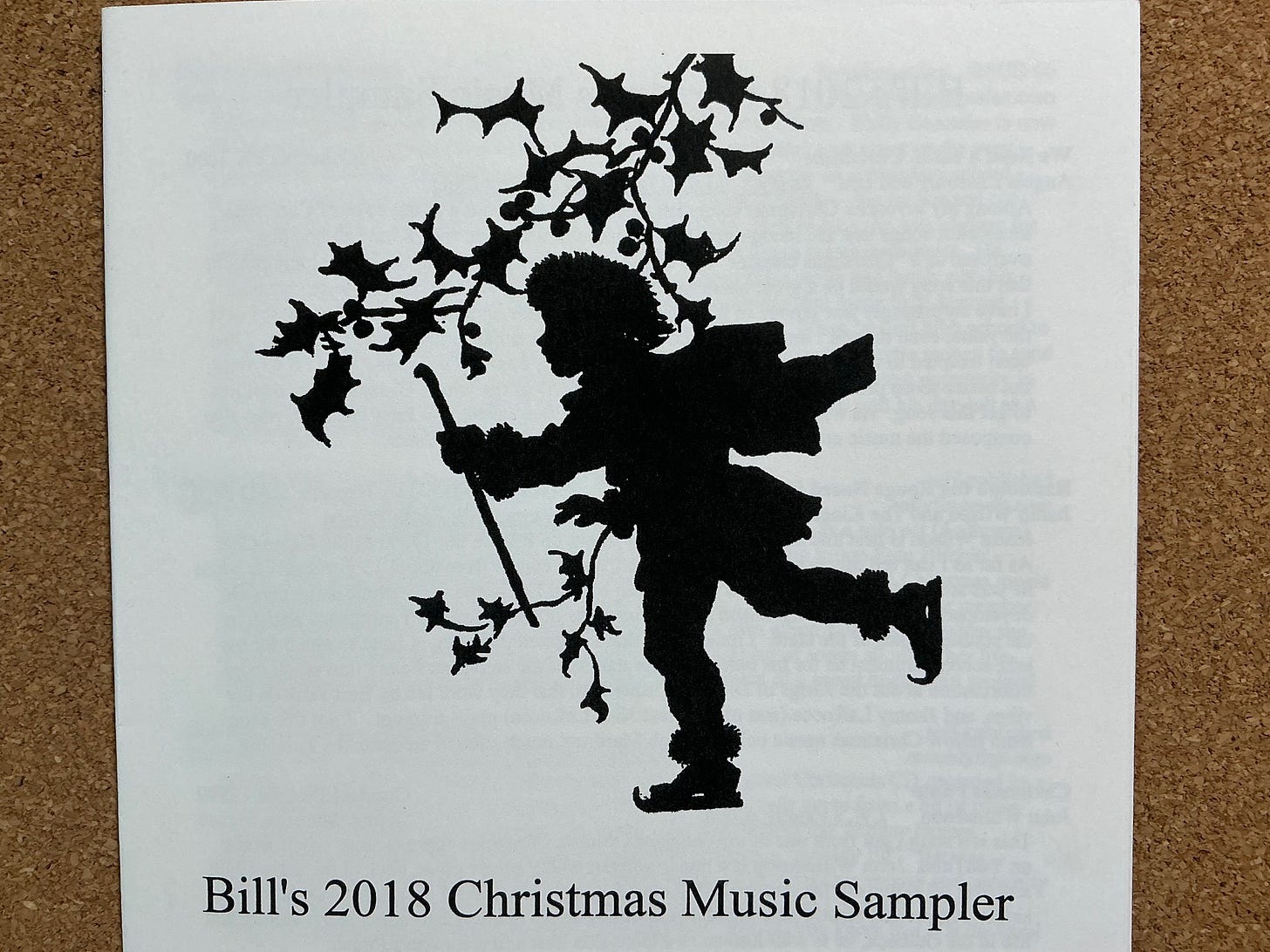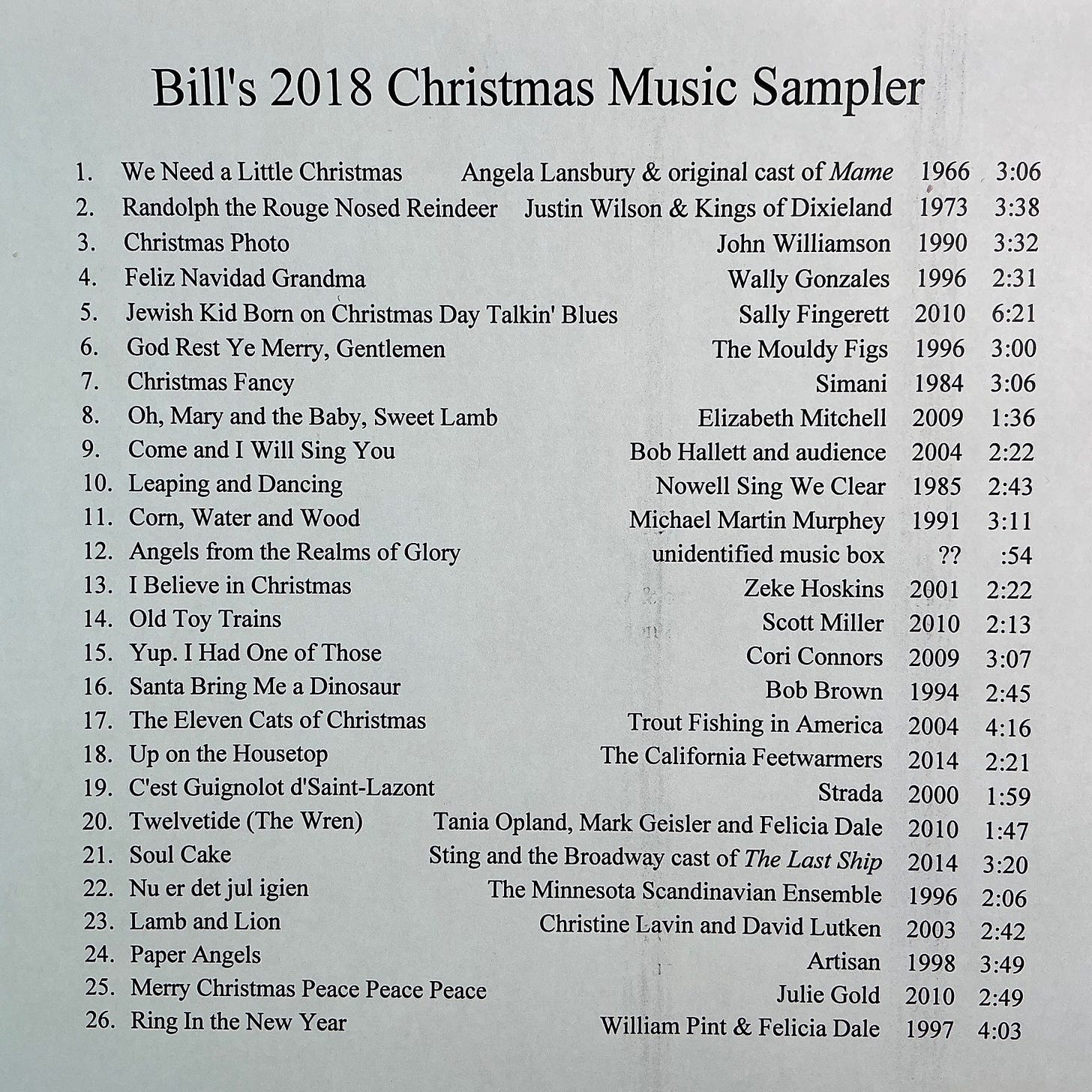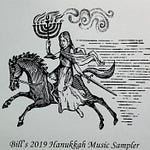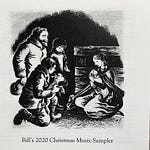Playlist:
Oh, Mary and the Baby, Sweet Lamb Elizabeth Mitchell 1:36
Feliz Navidad Grandma Wally Gonzales 2:31
Nu er det Jul igien The Minnesota Scandinavian Ensemble 2:06
Christmas Photo John Williamson 3:32
Come and I Will Sing You Bob Hallett and audience 3:35
Joy Janis Ian 2:38
Music notes
Oh, Mary and the Baby, Sweet Lamb For me it just wouldn't feel right to compile one of my children’s-album-for-grownups without including at least one song from Ruth Crawford Seeger's influential 1951 songbook American Folk Songs for Christmas (which, by the way, is no longer out-of-print; a paperback edition has now been published.)
Seeger found it from the Folk Music Archives in the Library of Congress, where it is a 1937 field recording made in Lubbock Texas by John Lomax from the singing of Ella Mitchell and Velma Wright. My guess is that she was tipped off to it by Lomax himself when she told him what kind of music she was seeking for a new format of Christmas pageant/recital that she was planning for her own music students, which later evolved into her book.
This is the opening song on Elizabeth Mitchell’s 2009 Smithsonian Folkways album The Sounding Joy which primarily features music from Seeger's songbook. I discovered it in our public library but immediately bought for myself after I heard how good it was. Elizabeth and her family and friends live in the musical community of Woodstock, NY. Among the friends who appear on this album are John Sebastian, Happy Traum, Natalie Merchant and Peggy Seeger. This is sung by Elizabeth, with refrain lines and hand-slapping by her 8 year-old daughter Storey and her friend Ken Ejinkonye.
Feliz Navidad Grandma Vancouver Island accordionist and folk tune-catcher Eric Oscar tipped me off to the album that I got this song from - Wally Gonzales’ self-published The Christmas Bandito which he released in 1996. Wally is about 80 years old now, and has lived most of his life in the Rio Grande Valley near Brownsville, on the Gulf coast at the very southern tip of Texas.
His childhood family had been very poor: his father was a migrant farm worker. He got his first accordion from an elementary school classmate whose family was otherwise going to throw it away. When he opened it he found a rat's nest inside (literally – the rat jumped out and scurried away.) He patched it up and began to learn how to play it.
Before long, he was playing for friends at school assemblies and his mother scrimped to buy him a better instrument. He found that his favorite aspect of entertaining was in making folks smile and laugh with his self-deprecating humor, so he turned to writing humourous songs that made light-hearted observations about the lives of Mexican-Americans and about himself. Even as an adult he was only 5’2” tall. He referred to himself a “low rider” in reference to the hopped-up cars, and a “short legged Texan.”
When he quit high school to work as a migrant farmworker himself he brought his accordion along to make extra money to send back to his mother. He found that he was making more money with the accordion than he did as a farm labourer, so he moved back to Brownsville and got a day job as a warehouseman and shipping clerk for Falcón Records, a label that promoted and distributed tejano (tex-mex music.) The owner there was willing to publish his albums as well as give him a very flexible work schedule. For his side-gig he bought a small trailer and travelled to county fairs and other weekend gatherings to entertain people and sell his albums.
By all accounts Wally was a greatly loved performer. He is now retired after a career in which he achieved considerable respect in the Latino community but as a regional entertainer, not much monetary reward. He never hired a business manager and never quit his day-job. You can learn more about him, and see some photos, in my Dec 11, 2023 newsletter, and find more of his music on YouTube by searching his name.
Nu er det Jul igien (Now it’s Christmas again) This is a traditional Swedish holiday dance tune played by The Minnesota Scandinavian Ensemble. I bought their 1996 CD It’s Holiday Time from the merch table when my father brought me to a gathering of the Norske Torske Klubben in St. Paul, Minn.
The purpose of that club is to promote Norse culture, but especially for its 400 or so members, to gather monthly to enjoy the Scandinavian delicacy of steamed torske (Atlantic cod). It was served on a white plate, with steamed peeled potatoes and a gravy boat filled with melted butter at the table for everyone to share. The men sitting at the table joked that the chef sprinkled a bit of green garnish on the cod and potatoes to assure you that the white plate isn’t empty.
My father had been a member of that club nearly since it was founded in 1966 even though membership is limited to people of Norse descent and he is pure French-Canadian. He told me that he got in by telling them that our family came from Normandy, and that their Viking ancestors raided the place so often he must have a lot of Viking blood in his heritage.
The Minnesota Scandinavian Ensemble is led by LeRoy Larson, who earned a PhD in Ethnomusicology by field collecting music from elderly Minnesota musicians. This is the tune for an old Christmas dance song that is very well-known in Sweden and Denmark. People traditionally sing it while dancing around the Christmas tree. You can watch and listen to the dancing and singing around a tree with real candles on it in this brief YouTube video.
I found the words to the song online. They translate as:
Now it’s Christmas again,
And now it’s Christmas again,
And Christmas lasts ’til Easter.
No that’s not true, no that’s not true,
Because in between comes the fast [during Lent.]
Christmas Photo I got this song from one of my daughter Gillian's own Christmas music compilations, who found it on YouTube. It was originally from John Williamson’s self-published JW’s Family Album released in 1990.
John Williamson has a music career going back to the early 1960s, and over 40 albums to his credit (selling over four million copies!) Besides his acclaim as a singer-songwriter, mostly penning and performing songs about Australian history, culture and life in the outback, he is well-known as a television presenter and a conservationist. He is in the Australian Country Music Hall of Fame, and is a Member of the Order of Australia. I just checked his website – he is still recording and after a 55 year career he has scheduled a My Travelling’ Days are Done tour beginning in January 2025.
Come and I Will Sing You This folksong was collected in 1980 by Genevieve Lehr and Anita Best from the singing of Jack Carroll, an elderly fellow who learned it growing up on Red Island in Placentia Bay, Newfoundland. Mr. Carroll did not know the meaning of the song, but said that it was “stuff from way back, really old, long before anybody's time.”
That is true. It is a sub-variant of a traditional cumulative religious song known by many other names including Ten Commandments, The Twelve Apostles, Green Grow the Rushes, and Children Go Where I Send You. Many, many variants have been collected from many places, suggesting that it is a very old song indeed. Three cumulative Nativity songs are included in Ruth Crawford Seeger's songbook alone, one of which is similar to this one. With so many widespread variants folklore scholars are puzzled as to the original origins of the song.
The most well-known cumulative traditional Christmas song is secular – The Twelve Days of Christmas and it isn’t related to this one. But all such songs are memory games. People cannot help but laugh as they begin to stumble through the ever-growing refrains.
Folk song variants arise when singers mishear the words and pass along a garbled version, or they purposely change and adapt them. Collectively, the changes are not deterioration of the original song but a polishing off of its rough edges the way that tumbling on a beach turns rough chunks of rock into smooth cobbles. This process was first identified as being both inevitable and beneficial by ethnomusicologist Charles Seeger. He was the one who gave the phenomenon the name “the folk process.”
Charles was the husband of Ruth Crawford Seeger, and father of Pete, Peggy and Mike Seeger. If American folk music had a royal family, they would be it, and Peggy would be its matriarch. To celebrate her 90th birthday she is now recording another album with hers sons Neill and Callum and they will be touring it next year.
But back to Come and I Will Sing You. It is not from an album. This is a recording of Bob Hallett of the Newfoundland folk-rock group Great Big Sea singing it exactly as it had been transcribed from Jack Carroll in a Oct 8, 2008 concert in Albuquerque, New Mexico.
The sometimes hard to understand additions to the refrain are: [2] of them are lily-white babes; [3] of them are drivers; [4] gospel preachers; [5] ferrymen under the bush; [6] are six pallbearers; [7] senators under the sky; [8] Gabriel angels; [9] bright-eyed shiners; [10] ten commandments; [11] eleven went straight to heaven; and [12] twelve apostles.
Joy It is hard to believe now, but in the late 1950s and early ‘60s both traditional folk songs and new compositions acoustically performed by singer-songwriters vied with rock music to become top hits on the pop music charts. Among them were Society's Child, recorded by a 14 year old named Janis Ian about the then-taboo subject of inter-racial romance.
It was followed a few years later by her At Seventeen about traumas caused by society's beauty standards. Ever since, she has continued to pen powerful songs of social and political commentary. Many of her compositions were considered by her record label's producers to be too politically controversial to be released, so she started her own record production company.
I first heard this song, which has lyrics like an Irish blessing, on Christine Lavin's 2010 Christmas music compilation Just One Angel. It was the last track. And like her, I considered it's good wishes for listeners to be the perfect way to close out my own 2018 Christmas Music Sampler.
Sampler-making recollections
This is another children’s-Christmas-album-for-grownups that is not really structured except for having a special introductory song and suitable closing mini-set. In between is a “musical Christmas stocking” of seemingly random songs that actually are carefully organized to flow comfortably from one to another.
Since 2013 my samplers had been a solstice one, my nautical one, and two with a nativity focus, so by 2018 I had a particularly good selection in my secular Christmas songs and tunes candidate files, and by this time I was also somewhat getting over my previous intention to separate the secular pieces from the nativity ones. Since it was never intended to have a “movement” structure I could choose from any candidates that weren’t in a file reserved for a special theme.
I began with a shortlist of prime contenders that added up to much more than 80 minutes. Then I began to make my first draft, both by copying the songs’ MP3 files onto a 2018 playlist in my Nero software and by cut & pasting the songs’ identity information to the top of my shortlist Word document in its place on the playlist. I began with the must-haves and moved on from there, picking additional songs that would complement and bind together the must-haves.
Choosing the songs that would begin and end my sampler have always been very important in setting the tone and flow of the whole compilation, but as in most years I had a pretty good idea of what songs those would be before I began the first draft. In 2018, as proved to be quite common, the opening and closing songs at remained stable until the end of the process. In the case of We Need a Little Christmas the only question was whether to retain the original cast recording or use another really good rendition I have, but Pint & Dale never really faced any competition for being the closing song.
When I had 80 minutes that I was happy with I burnt Draft 1 and printed off my Word document listing, with the playlist being triple spacing so that I would have room for taking notes, and the list of other prime candidates below that. I listened to each draft twice before making changes for the next one.
If when making the next draft I decided to drop a song or tune from the playlist it would go back onto the shortlisted candidates list (unless I dropped it because I was getting tired of it, or irritated by something about it, in which case it didn’t stay in my candidate files at all.) This proved to be very useful because sometimes my first impressions had been correct and the dropped selection later came back into a different place in the order where its merit shined through.
Sometimes listening to the Draft brought to mind a different song, tune or rendition from my collection that would be perfect for this particular developing sampler. So the ones that I added to the playlist didn’t always come from my shortlist, or even necessarily from the ones I had ripped into my candidates files. So my list of shortlisted candidates kept growing.
After the first few drafts, when it was clear that some of the songs would definitely be keepers, I began to write their liner notes. I didn’t have an overall story I wanted to tell so they were all about the performer, the song or tune, or about its social/historical context. (Sometimes it was all three of those, which explains why some of my above music notes are long and detailed.) Sometime my write-ups became part of the feedback loop for the sampler draft, when I was inspired to bring in another song to complement one I was writing about.
I didn’t keep my working documents when this year’s sampler was completed so I am not sure how many drafts it took to produce this final product. My guess would be about eight to ten. I do remember that it was fun because I had so many good selections to choose from, and not having the three-movement structure gave this year’s project a lot of freedom.













Share this post